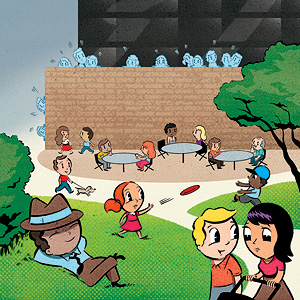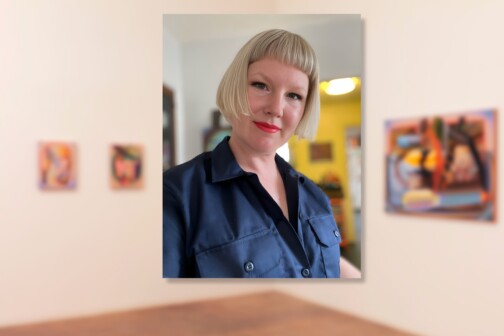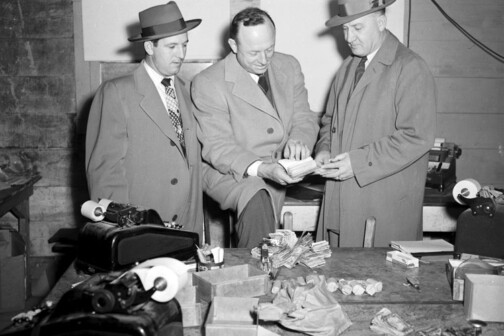Sometime next year, Belo Garden will open to the public. Situated on Griffin between Main and Commerce streets, the $13 million, 1.5-acre park will feature perennials, shaded groves, and an interactive fountain in a central plaza. When Belo Corp., owner of the Dallas Morning News, announced in 2006 that it was committing $6.5 million to the project, C.W. Whitaker, former president of the Dallas Park and Recreation board, said, “Belo Garden will provide an urban oasis for downtown Dallas residents, workers, visitors, and students and will also stimulate economic development.”
I have my doubts. One major obstacle stands in the way of Belo Garden’s success. It’s a planned stone-clad wall that will stand 12 feet high and stretch for more than 60 yards, from Main to Commerce, separating the park from its immediate neighbor, the Metropolitan building. The wall says a lot about how development happens in downtown Dallas—and about how little we still seem to understand about urbanism.
The Metropolitan was an office building until it was renovated in 2005. Now it’s 26 floors of condos. The Belo Garden essentially serves as its front yard, so residents are understandably displeased about Belo’s walling it off. They say it will create a tunnel between the park and building, that it will ruin sightlines and endanger pedestrians. The Metropolitan’s lobby has a 24-hour concierge that would put eyes on the park and increase safety—if there weren’t a 12-foot-high barrier. Residents call it The Wall of Spite, claiming Belo is erecting it only because the Metropolitan refused to allow its driveway to become part of the park’s acreage.
“I’ve lived downtown for years, and the addition of parks is a wonderful idea,” says Brandon Fleeman, a Metropolitan resident. “None of the other parks have walls in their design. It just seems that Belo is trying to flex its muscle and doesn’t care about downtown residents. They are just happy to shell out $750,000 to build this wall. It’s crazy.”
A media representative for Belo defended the wall to the Observer, saying that it “is necessary to preserve the intimate garden-like feel.” But if you’ve been to walled-off Thanks-Giving Square, you know what intimacy really means. It means emptiness.
Walls are antithetical to good urban design. Walls quarantine physical pathogens to the living system of cities, often referred to as Locally Undesirable Land Uses (LULUs). Typically with LULUs, incompatible projects wind up as neighbors—your house sitting next to, say, a lead smelter. But it doesn’t get much more complementary than putting a park next to a residential building, which is why parks drive up the value of residential land within walking distance. Urbanism is about agglomerating compatible projects so that the value of the whole is greater than the sum of its parts. Think of a jigsaw puzzle. Any two pieces have a relationship. Everything has its place. The closer the pieces, the stronger that relationship must be.
The Wall of Spite reminds me of a scene I observed recently on the other end of Main Street from the Belo Garden. On a beautiful 70-degree late-winter Sunday, I was in Main Street Garden, sitting on one of the low stone seat walls, reading a book. Peering up from the pages, I watched two guys stride out onto the lawn, each holding a baseball glove. They may as well have been models hired for a photo shoot to produce a marketing brochure to lure affluent, young professionals to the city’s core.
Then, after about fifteen minutes of watching the two yuppies play catch, a homeless man asked if he could join them. One of the yuppies offered his glove, and they began to play. Black and white, poor and not poor, enjoying an impromptu game of catch in the park.
Contrast that kumbaya moment with the prevailing ethos of North Texas urban development, of self-interest and perhaps even spite, where everything and everyone is a LULU. Rather than cooperate to achieve mutual interests, a developer builds to suit only himself.
If the design (by) committee wants the Metropolitan’s driveway to be part of the park, they should do the right thing, which is to design and construct the building’s drop-off so that it can still function as such while maintaining low traffic speeds and feeling like it’s part and parcel of the park. They should design a woonerf. A woonerf—a Dutch word meaning living space—is a low-speed street designed for bikes, pedestrians, and cars to coexist on what is effectively a plaza you can drive through, where children can play safely.
If Belo’s Berlin Wall is built, we should treat it like one, as a canvas for “street art” until the graffiti is less palatable than the wall itself.
Write to [email protected].






